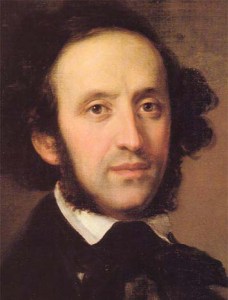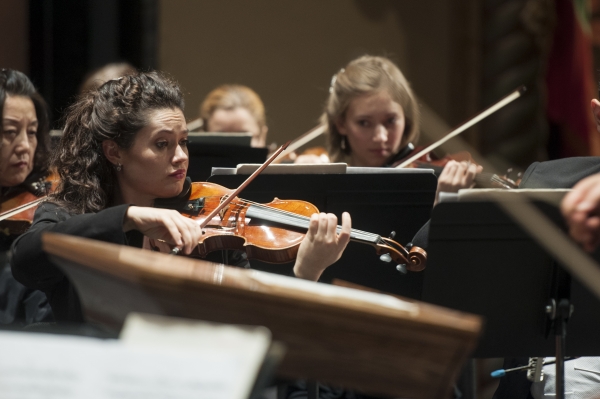The Knoxville Symphony Orchestra Masterworks
“Mozart and Mendelssohn”
Thursday and Friday, March 19, 20, at 7:30 p.m., Tennessee Theatre
Conductor: James Feddeck
Rossini: The overture to William Tell
Mozart: Piano Concerto No. 25 in C Major, K. 503; Conrad Tao, piano
Mendelssohn: Symphony No. 3, “Scottish”
Tickets start at $15
Gioachino Rossini is a name known, at least peripherally, by a large percentage of Knoxvillians—for no other reason than for being the namesake of the incredibly popular springtime Knoxville Opera festival and street fair. Opera followers, though, know him as an incredibly prolific composer who, for nineteen years between 1810 and 1829, turned out opera after opera. Then, he simply, somewhat mysteriously, stopped composing operas at age 37, even though he lived another 40 years. Rossini’s own responses to inquiries about his operatic retirement meandered from personal/health reasons to the political and social climate in Europe. However, one cannot discount the simple explanation that he was now relatively rich and did not want to put up with the fickleness of 19th Century taste and the changing production environment in Europe.
Rossini’s 39th and last opera was Guillaume Tell (William Tell)—premiered by the Paris Opera in August, 1829—an opera that today is rarely performed for reasons ranging from its length (over four hours) to its difficulty in casting some of the roles. However, its overture is an entirely different matter. The Overture to William Tell is clearly one of the most addictively energetic works ever written, as well as one of the most recognized pieces in the history of music across all age groups. Despite its frequent use in all sorts of modern media, it is a work that is still immensely compelling, if not downright exciting, to hear in a live performance.

At the very time that Guillaume Tell was receiving its premiere on August 3, 1829, the 20-year old Felix Mendelssohn was making his way through sites in Scotland with a friend, Carl Klingemann, a diplomat representing the Kingdom of Hanover in London. Mendelssohn had come to England in March of that year for both professional and social reasons, the former being to conduct performances of his music, notably his Symphony No. 1 in C Minor at the Royal Philharmonic Society.
In a letter, Mendelssohn described what would be the inspiration for his “Scottish Symphony.”
“In the evening twilight we went today to the palace where Queen Mary lived and loved; a little room is shown there with a winding staircase leading up to the door… The chapel close to it is now roofless, grass and ivy grow there, and at that broken altar Mary was crowned Queen of Scotland. Everything round is broken and mouldering and the bright sky shines in. I believe I today found in that old chapel the beginning of my ‘Scottish’ Symphony.”
However, other than jotting down the first sixteen measures of what would be the opening of the “Scottish,” recapturing the essence and spirit of his Scotland experience eluded Mendelssohn until 1842. Mendelssohn conducted the premiere on March 3 of that year with the Leipzig Gewandhaus Orchestra.
For many, including this writer, Mendelssohn’s “Scottish” Symphony is his ultimate orchestral work. Having said that, I caution first time listeners against expecting the sounds of folktunes, bagpipes, or other Scottish minutiae. Instead, expect one of the most skillfully constructed impressionistic works imaginable, free of any particular program, in music. However, if you find yourself transported to a windswept moor, a rocky crag, or a ruined castle, thank Mendelssohn for the brilliance.
Records tell us that Mozart premiered the Piano Concerto No. 25 in C Major, K. 503, in Vienna on December 5, 1786, shortly after completing it. Also completed during that time frame was his Symphony No. 38 in D Major, K. 504. Mozart then set out for Prague where Le Nozze di Figaro was in production and where he hoped to have performances of the concerto and the symphony. On January 19, 1877, he conducted a performance of the symphony that would later be nicknamed the “Prague” Symphony. Unfortunately, the concerto did not fare as well, as there is no record of a performance in Prague. Although Mozart did perform the concerto several times later that spring in Vienna and Leipzig, it failed to get another performance during his lifetime. In fact, there is no record of it being performed for 147 years until Artur Schnabel played it with the Vienna Philharmonic under George Szell in 1934.
Reading between the lines and adding in the history, one might conclude that Mozart’s aim in this concerto was to give himself a field on which the pianist has a grand, sumptuous, and somewhat formal orchestration base on which to contrast the vibrant piano line. The fact that Mozart did not write out any cadenzas for the concerto seems to support this idea.








